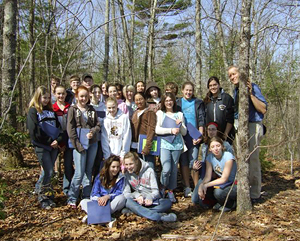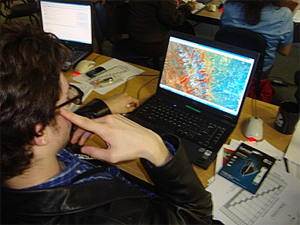New Research Materials
- Exploring Stress in the White Pines (ppt presentation 11/2012)...
- What Does Our Spectral Data Tell Us About the Health of Our White Pine?...
- What Does Our Spectral Data Tell Us About the Health of Our White Pine?...
- Is There a Relationship Between Weather and Our Trees' Health?...
- How Have Gilmanton's White Pines Changed Over Time...
- How Gilmanton's White Pine Trees' Health Compare to Other Sites...
Materials for Schools
Forest Watch is interested in providing enrichment materials for teachers in science, technology and math, three of the STEM education fields. Forest Watch also aims to introduce teachers and students to 21st century perspectives in learning such as how remote sensing tools from space can be applied to biological and chemical studies in the school yard.
Forest Watch teachers at every grade level K to 12 have adapted Forest Watch materials to their students’ learning needs and interests as well as to curricular programs and state standards. Forest Watch, students participate in several types of activities:
- Forestry studies of white pines introduce students to skills and tools used in many environmental fields.
- Forest Watch classrooms become biological laboratories as students collect and build biometric data with their fieldwork and samples.
- Forest Watch students invariably discuss the relationship of plant and atmospheric chemistry.
- Forest Watch students and teachers submit a set of needles to UNH for spectral analysis.
- Forest Watch also invites schools to apply remote sensing data, satellite imagery collected by Landsat Thematic Mapper, to their school studies.
Students select five white pine trees to be permanently tagged near their school. They establish a 30x30 meter sampling plot. They learn a suite of forest plot biometric measurements such as tree height, diameter at breast height (DBH), canopy closure and ground cover.
Forest Watch students love to core their white pines to count tree rings and to calculate the age of their trees. Students also love using global positioning systems to find the latitude, longtitude and elevations of their schools.
 |
|
| Forest Watch students, Merrimack Middle School. |
Students measure and record some 20 different measures of white pine needles as they consider the health of the needles and look for any signs of ozone damage. Students perform simple mathematical calculations of percent damage. Students measure and calculate water content of the needles. And they learn to make fresh sections of needles and to study plant anatomy at the microscopic level.
What is ozone? How is it formed? How do plants react to air pollutants? What anatomical features protect plants from damage? Why is the white pine an indicator of ozone damage? Many Forest Watch schools go on to discuss the Clean Air Act, automobile exhaust and other sources of air pollution, and how student data has helped to improve air quality in New England.
The needles are scanned in the Forest Watch Visible Infrared Intelligent Spectrometer. Readings of reflectance from the needles is returned to each school.
 |
|
| The reflectance of plants measured in the laboratory can be correlated with reflectance captured 500 miles above by Landsat remote sensing. |
The light reflected from one school’s white pines will be similar to light reflected by an entire white pine forest. As students learn about the health of their white pines, they can extrapolate that information to “read” the health of a region’s white pines.
Forest Watch provides very inexpensive or free materials to teachers. Workshops for training and upgrading teacher skills are scheduled each summer. The Forest Watch staff also visits Forest Watch schools to assist at any stage of a Forest Watch program.
|
|---|
|
|---|
|
|---|
